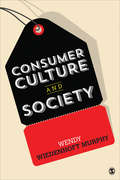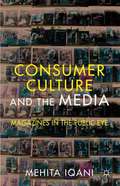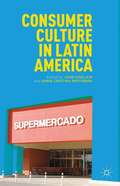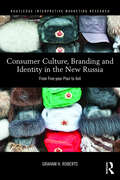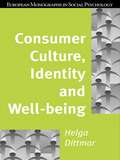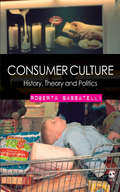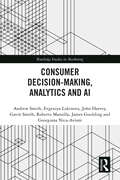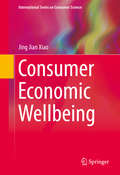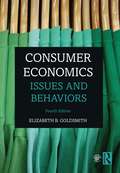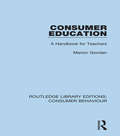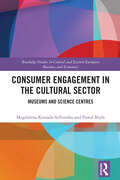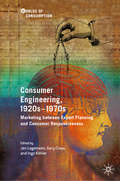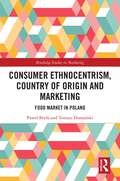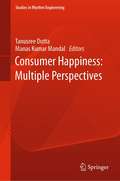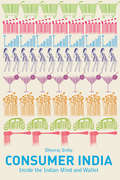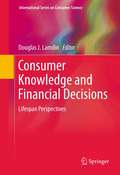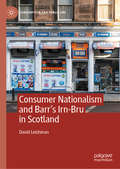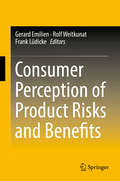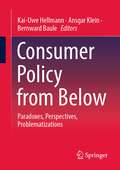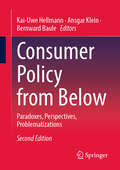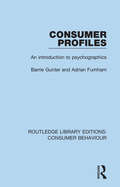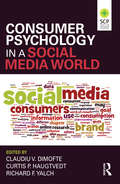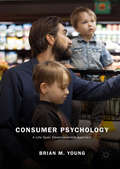- Table View
- List View
Consumer Culture and Society
by Wendy Wiedenhoft MurphyThe author is a proud sponsor of the 2020 SAGE Keith Roberts Teaching Innovations Award—enabling graduate students and early career faculty to attend the annual ASA pre-conference teaching and learning workshop. Consumer Culture and Society offers an introduction to the study of consumerism and mass consumption from a sociological perspective. It examines what we buy, how and where we consume, the meanings attached to the things we purchase, and the social forces that enable and constrain consumer behavior. Opening chapters provide a theoretical overview and history of consumer society and featured case studies look at mass consumption in familiar contexts, such as tourism, food, and higher education. The book explores ethical and political concerns, including consumer activism, indebtedness, alternative forms of consumption, and dilemmas surrounding the globalization of consumer culture.
Consumer Culture and the Media
by Mehita IqaniHow did consumer culture become synonymous with westernised societies? Iqani argues that it is the way it is promoted by media texts. She provides a detailed analysis of publicly displayed consumer magazine covers and engages with big questions about the public, power and identity in mediated consumer culture.
Consumer Culture in Latin America
by John Sinclair Anna Cristina PertierraHow can we understand consumption in a region known for its cultural richness and vast inequalities? What do Latin Americans consume, and why? Examining topics from tango and samba to sex workers in Costa Rica, from eating tamales to selling ice in the Andes, and from building and moving houses to buying cell phones, this collection brings together original research on some of the many forms of consumption and consumers that contribute to Latin American cultures and histories. Contributors include sociologists, anthropologists, media and cultural studies scholars, geographers and historians, showcasing diverse approaches to understanding Latin American consumption practices and consumer culture.
Consumer Culture, Branding and Identity in the New Russia: From Five-year Plan to 4x4 (Routledge Interpretive Marketing Research)
by Graham H.J. RobertsAs shopping has been transformed from a chore into a major source of hedonistic pleasure, a specifically Russian consumer culture has begun to emerge that is unlike any other. This book examines the many different facets of consumption in today’s Russia, including retailing, advertising and social networking. Throughout, emphasis is placed on the inherently visual - not to say spectacular - nature both of consumption generally, and of Russian consumer culture in particular. Particular attention is paid to the ways in which brands, both Russian and foreign, construct categories of identity in order to claim legitimacy for themselves. What emerges is a fascinating picture of how consumer culture is being reinvented in Russia today, in a society which has one, nostalgic eye turned towards the past, and the other, utopian eye, set firmly on the future. Borrowing concepts from both marketing and cultural studies, the approach throughout is interdisciplinary, and will be of considerable interest, to researchers, students and practitioners wishing to gain invaluable insights into one of the most lucrative, and exciting, of today’s emerging markets.
Consumer Culture, Identity and Well-Being: The Search for the 'Good Life' and the 'Body Perfect' (European Monographs in Social Psychology)
by Helga DittmarAdvertising, materialism and consumption are central aspects of contemporary Western culture. We are bombarded with idealised images of the perfect body, desirable consumer goods, and affluent lifestyles, yet psychology is only just beginning to take account of the profound influence these consumer culture ideals have on individuals’ sense of identity and worth. Consumer Culture, Identity, and Well-Being documents the negative psychological impact consumer culture can have on how individuals view themselves and on their emotional welfare. It looks at the social psychological dimensions of having, buying and wanting material goods, as well as the pursuit of media-hyped appearance ideals. In particular, it focuses on: the purchasing of material goods as a means of expressing and seeking identity, and the negative consequences of this psychological buying motivations in conventional buying environments and on the Internet the unrealistic socio-cultural beauty ideals embodied by idealized models. Throughout, different approaches from social psychology are integrated, such as self-completion, self-discrepancy and value theory, to create a comprehensive theoretical framework for understanding the impact of internalising core consumer culture ideals on how individuals see themselves and the implications this has for their psychological and physical health.This book is of interest to anybody who wants to find out more about the psychological effects of living in modern consumer societies on children, adolescents, and adults. More specifically, it will be of interest to students and researchers in social psychology, sociology, media studies, communication and other social sciences, as well as to psychologists, health workers, and practitioners interested in the topics of identity, consumption pathologies, body image, and body-related behaviours.
Consumer Culture, Modernity and Identity
by Nita MathurThis book offers analysis of articulation of consumer culture and modernity in everyday lives of people in a transnational framework. It pursues three broad themes: lifestyle choices and construction of modern identities; fashion and advertising; and subaltern concerns and moral subjectivities. It juxtaposes empirical studies with theoretical traditions in addressing questions such as: How do people imagine modernity and identity in consumer culture? What does modernity or 'being modern' mean to people in different societies? Are modernity and tradition antithetical to or develop an interface with each other? The chapters in the book trace manifestations and trajectories of consumer culture and modernity as they connect to develop a sense of renewed identity.
Consumer Culture: History, Theory and Politics
by Dr Roberta Sassatelli"A thorough and wide-ranging synthetic account of social scientific research on consumption which will set the standard for the second generation of textbooks on cultures of consumption." - Alan Warde, University of Manchester "The multi-disciplinary nature of the book provides new and revealing insights, and Sassatelli conveys brilliantly the heterogeneity and ambivalent nature of consumer identities, consumer practices and consumer cultures... Newcomers to consumer culture will find this an invaluable primer and introducton to the major concepts and ideas, while those familiar with the field will find Sassatelli's sharp analysis and discussion both refreshing and inspiring." - James Skinner, Journal of Sociology "This is a model of what a text book ought to be. Over the past decade the original debates about consumption have been overlaid by a vast amount of detailed research, and it seems unimaginable that a single text couuld do justice to all of these. To do so would involve as much a commitment to depth as to breadth. I was quite astonished at how well Sassatelli succeeds in balancing the two... Ultimately, it's the book that I would trust to help people digest what we now have discovered about consumption and start from a much more mature and reflective foundation to consider what more we might yet do." - Daniel Miller, Material World Showing the cultural and institutional processes that have brought the notion of the 'consumer' to life, this book guides the reader on a comprehensive journey through the history of how we have come to understand ourselves as consumers in a consumer society and reveals the profound ambiguities and ambivalences inherent within. While rooted in sociology, Sassatelli draws on the traditions of history, anthropology, geography and economics to provide: a history of the rise of consumer culture around the world a richly illustrated analysis of theory from neo-classical economics, to critical theory, to theories of practice and ritual de-commoditization a compelling discussion of the politics underlying our consumption practices. An exemplary introduction to the history and theory of consumer culture, this book provides nuanced answers to some of the most central questions of our time.
Consumer Decision-Making, Analytics and AI (Routledge Studies in Marketing)
by John Harvey Andrew Smith Gavin Smith James Goulding Evgeniya Lukinova Roberto Mansilla Georgiana Nica-AvramMany decisions in our lives are decisions we make as consumers and buyers. Analytics- driven marketing underpinned by machine learning and AI has had a seismic impact on the execution of these decisions and on behavioural outcomes. This book dissects processes and issues at the heart of our emerging reality as human actors embedded in a system of exchange driven by fast-evolving technologies. It is a seminal work on a complex but urgent issue in social and behavioural science.Based on extant and emerging research, the book presents new evidence and innovative theoretical structures and concepts to explore how data analytics and AI can influence consumer thinking and behaviour. It synthesizes consumer research with the relevant literature on computational ‘thinking,’ human– computer interaction, AI, decision delegation and consumer analytics, linking them in a coherent fashion. The authors utilize original exhibits and real- world data in an accessible format to both engage and challenge the reader.This cutting- edge book is a must- read for scholars and upper- level students researching and studying marketing, consumer behaviour, AI, decision-making and behavioural science.
Consumer Economic Wellbeing (International Series on Consumer Science)
by Jing Jian XiaoThis book focuses on the development of relevant theories and concepts that aid in predicting and modifying consumer behaviors. Consumer behaviors that help improve well-being, such as earning, spending, borrowing, and saving are also covered. In addition, the book discusses how to define consumer rights and responsibilities, and how individual consumers are organized to protect their own interests and to voice their concerns in public decision making processes. Finally, the book covers effects of economic environments on consumer well-being and how consumers can effectively deal with these challenges.
Consumer Economics: Issues and Behaviors
by Elizabeth B. GoldsmithFrom artificial intelligence to identity theft, from what we once thought of as unshakeable institutions to increasing concerns about privacy and sustainability, consumer issues are an integral part of daily life. This updated fourth edition of Consumer Economics offers students an accessible and thorough guide to the concerns surrounding the modern consumer and brings to light the repercussions of making uninformed decisions in today’s global economy. This definitive textbook introduces students to these potential issues and covers other key topics including consumer behavior, the history of the consumer movement, personal finance, legal rights and responsibilities, and marketing and advertising. Combining theory and practice, students are introduced to both the fundamentals of consumer economics and how to become better-informed consumers themselves. Highlights in this new edition include the following: New case studies and critical thinking projects to encourage students to develop their critical thinking skills through analyzing consumer issues. Expanded coverage of social media and the impact of social influence on consumers. Revised consumer alerts: practical advice and guidance to help students make smart consumer decisions. A companion website with PowerPoint slides for each chapter. Fully updated, this textbook is suitable for students studying consumer sciences—what works, what does not, and how consumers are changing.
Consumer Education: A Handbook for Teachers (Routledge Library Editions: Consumer Behaviour)
by Marion GiordanEducation in consumer affairs has become increasingly important in recent years with the growth of consumer societies in many parts of the world. This practical handbook is a guide to teachers on the various aspects of the field; it looks at the consumer world in its political, social and economic context, describing how teachers have approached some of the subjects discussed in the book in class. Although based on the UK experience, it contains many references to global consumerism.
Consumer Engagement in the Cultural Sector: Museums and Science Centres (Routledge Studies in Central and Eastern European Business and Economics)
by Magdalena Kosiada-Sylburska Paweł BryłaThe essence of the book is to investigate the forms, benefits and limitations of engaging consumers in the development of cultural institution offerings. It aims to identify methods for culture product development with consumer engagement, in particular concerning exhibition and educational activities of cultural institutions. The volume provides an extensive literature review of issues related to market orientation, customer centricity, consumer engagement and co-creation of products and services, with an emphasis on the specificity of the cultural sector.The authors conduct research to capture different perspectives on consumer engagement, including those of consumers themselves, managers responsible for designing the offer and cultural institution employees. They identify forms, success factors of and barriers to involving consumers (visitors) in the development of museum offerings. The combination of quantitative and qualitative research methods provides novel and valuable insights into the phenomenon under study. This book will be of interest to scholars interested in culture marketing and consumer behaviour, as well as managers of museums, science centres and other cultural institutions.
Consumer Engineering, 1920s–1970s: Marketing between Expert Planning and Consumer Responsiveness (Worlds of Consumption)
by Gary Cross Jan Logemann Ingo KöhlerIn the middle of the twentieth century, a new class of marketing expert emerged beyond the familiar ad men of Madison Avenue. Working as commercial designers, consumer psychologists, sales managers, and market researchers, these professionals were self-defined “consumer engineers,” and their rise heralded a new era of marketing. To what extent did these efforts to engineer consumers shape consumption practices? And to what extent was the phenomenon itself a product of broader social and cultural forces? This collection considers consumer engineering in the context of the longer history of transatlantic marketing. Contributors offer case studies on the roles of individual consumer engineers on both sides of the Atlantic, the impact of such marketing practices on European economies during World War II and after, and the conflicted relationship between consumer activists and the ideas of consumer engineering. By connecting consumer engineering to a web of social processes in the twentieth century, this volume contributes to a reassessment of consumer history more broadly.
Consumer Ethnocentrism, Country of Origin and Marketing: Food Market in Poland (Routledge Studies in Marketing)
by Paweł Bryła Tomasz DomańskiCountry of origin and consumer ethnocentrism are evolving constructs as consumers’ perception of country, state, or region changes over time. Understanding consumer motivations and attitudes towards a country and its products can provide valuable insights for marketing strategies. This book explores the phenomena of consumer ethnocentrism and country-of-origin effect on the food market using examples from Polish retailers. The book aims to determine how appeals to the domestic or foreign country-of-origin provided through claims, symbols, labels, and quality signs can affect consumer attitudes and food purchase intentions as well as to contextualise consumer behaviour issues in the broader picture of the entire system of food production and distribution. The reader will gain a comprehensive understanding of consumer ethnocentrism and country-of-origin effect on the food market based on a series of original research studies conducted in Poland. The combination of quantitative and qualitative research methods provides novel and valuable insights into the phenomena under study. Based on original research, this innovative volume will be a valuable resource for consumer behaviour, food marketing, and international marketing scholars and students.
Consumer Happiness: Multiple Perspectives (Studies in Rhythm Engineering)
by Tanusree Dutta Manas Kumar MandalThis book helps quench the quest of knowledge of academicians, researchers, and others interested in developing a complete and critical understanding of consumer happiness. The relentless search of happiness by humans is sought in different ways. Scientific discussion on happiness for long was considered a forte of Philosophers. Other disciplines seldom delved into this. But today not only science but neuroscience, marketing, and other varied fields have started delving into it and have developed a keen interest. The book has been conceptualized on this line of thinking and thus divided into two parts. The first part is customized towards understanding various perspectives of happiness and the relative importance of knowing the same. The first chapter of this section is on the biological perspective of happiness. The second is titled ‘Behavioural perspective’. The third chapter is an attempt to elucidate the cultural perspective of the concept of happiness. The fourth is on the role of technology in inducing happiness. Fifth and sixth are on theories of happiness and measuring happiness, respectively. Knowledge about the different perspective and theories has a wide range of benefits. It informs us about how the brain works, interprets, and reacts. This theoretical understanding helps us to move beyond the trial and error methods towards a more scientific underpinning of adoption of measures that would generate long-lasting happiness in consumers.The second part of the book is dedicated toward understanding consumer happiness from a neuroscience perspective, i.e. keeping consumer happy. This segment has ten chapters. The first is on differentiating the concept of happiness from satisfaction. The second is on sensory marketing and happiness. The third deals with the store design and shelving of products to generate happiness. Fourth and fifth chapters relate to persuading the consumers. While the fourth chapter is on developing persuasive messages and the fifth is on subliminal messaging sixth chapter is on pricing and seventh on advertising. The eighth chapter highlights the role of emotions and the ninth is on the different factors that induce happiness in consumers. The last chapter is about raising some unanswered questions and food for thought for readers. Together the contents of the book make for a complete understanding of the concept of happiness and how it is shaping the world of marketing. Addressing the ‘what’ and ‘how’ of consumer happiness in the same book makes the book comprehensive.
Consumer India
by Dheeraj SinhaA richly insightful account of one of the most significant transformations in the world today. Dheeraj Sinha's intelligence vividly illuminates the intersection of culture and commerce in New India. Adam Morgan Founder eatbigfish Among the many books I have read on the cultural evolution taking place in India, this is perhaps the most insightful. It does not just map mindset changes; it does so with the certainty of a person who has lived the changes as much as he has witnessed them. Every marketeer should keep this book on his office desk as a ready reckoner. Ranjan Kapur Country Manager - India WPP India in many ways is a "Nation of Nations. " So much heterogeneity and hence complexity in understanding consumers and consumerism. Dheeraj has done a commendable job in peeling off the layers from the onion-creating frameworks and providing very relatable examples to understand the culture. For instance, Dheeraj has used Bollywood as an effective mirror to portray societal changes. Consumer India is a must-read for those who want to understand the cultural evolution of India with its nuances. Rajesh Jejurikar Chief Executive - Automotive Division Mahindra & Mahindra Ltd. A labor of love. For years, I have marveled at how Dheeraj's inquisitive brain continuously churns away to make meaning of everything he observes. His writing simultaneously reflects him as a "sutradaar" telling the captivating story of a changing India, even as it does so with the unbiased and expert credentials of the "computerji" he describes here. Dheeraj insightfully marries the rapid changes he chronicles with the assimilative fabric of India; where "and" trumps "or. " Against the cliché "change is the only constant," he underlines that in India, change works with the constant. Enjoy the ride on Dheeraj's time machine! Prasad Narasimhan Managing Partner, Asia Brandgym
Consumer Knowledge and Financial Decisions: Lifespan Perspectives (International Series on Consumer Science)
by Douglas J. LamdinThere has been an increasing recognition that financial knowledge (i.e., literacy) is lacking across the population. Moreover, there is recognition that this lack of knowledge poses real problems as credit, mortgages, health insurance, retirement benefits, and savings and investment decisions become increasingly complex. Financial Decisions Across the Lifespan brings together the work of scholars from various disciplines (family and consumer sciences, economics, law, finance, sociology, and public policy) to provide a broad range of perspectives on financial knowledge, financial decisions, and policies. For consistency across the volume each chapter follows a similar format: (1) what individuals know or need to know (2) how what they know or need to know affects financial decisions and outcomes (3) ways in which policies or programs or financial innovations can enhance their knowledge, or decisions, or outcomes. Contributors will provide both new and existing research to create a valuable picture of the state of financial literacy and how it can be improved.
Consumer Lending in France and America
by Gunnar TrumbullWhy did America embrace consumer credit over the course of the twentieth century, when most other countries did not? How did American policy makers by the late twentieth century come to believe that more credit would make even poor families better off? This book traces the historical emergence of modern consumer lending in America and France. If Americans were profligate in their borrowing, the French were correspondingly frugal. Comparison of the two countries reveals that America's love affair with credit was not primarily the consequence of its culture of consumption, as many writers have observed, nor directly a consequences of its less generous welfare state. It emerged instead from evolving coalitions between fledgling consumer lenders seeking to make their business socially acceptable and a range of non-governmental groups working to promote public welfare, labor, and minority rights. In France, where a similar coalition did not emerge, consumer credit continued to be perceived as economically regressive and socially risky.
Consumer Nationalism and Barr’s Irn-Bru in Scotland: Iron Nation (Consumption and Public Life)
by David LeishmanThis book connects a detailed analysis of Irn-Bru’s brand identity over time to theories of national identity, consumer studies, and banal nationalism. It situates the commercial history of Barr’s Irn-Bru in a transnational context and shows how Irn-Bru has become a symbol of Scotland through processes of rewriting, reframing and institutionalized forgetting, linking the consumption of what began as a trans-national generic product to a specific national community. As such, Leishman presents a longitudinal, cross-disciplinary approach to analysing branding and advertising as multi-modal forms of discourse, in order to underline the role of commercial, non-state actors and popular consumerism in the phenomenon of banal nationalism. It will be of interest to students and scholars researching nationalism, consumption, and Scottish studies.
Consumer Perception of Product Risks and Benefits
by Gerard Emilien Rolf Weitkunat Frank LüdickeThis book reflects the current thinking and research on how consumers' perception of product risks and benefits affects their behavior. It provides the scientific, regulatory and industrial research community with a conceptual and methodological reference point for studies on consumer behavior and marketing. The contributions address various aspects of consumer psychology and behavior, risk perception and communication, marketing research strategies, as well as consumer product regulation. The book is divided into 4 parts: Product risks; Perception of product risks and benefits; Consumer behavi∨ Regulation and responsibility.
Consumer Policy from Below: Paradoxes, Perspectives, Problematizations
by Ansgar Klein Kai-Uwe Hellmann Bernward BauleSince its existence in the 1950s, consumer policy in Germany has been understood and pursued primarily as a bundle of actions and measures initiated and institutionalised by the state. In many cases, the state has also issued corresponding mandates and set up support models, which has created the impression that we are basically dealing with a 'consumer policy from above' imposed by macro-politics. Not that there have not been repeated attempts in the past decades to give impetus to consumer policy from the middle of civil society - often in the form of small citizens' initiatives. And in recent years in particular, a number of new consumer organisations have emerged which operate much closer to the grass roots. Nevertheless, the impression seems to have taken root among the large, government-related 'players' in the field, who have been in the 'business' for decades, not to mention government-internal consumer policy, that consumer policy concerns a policy field that is essentially ordered by a collaboration of the state on the one hand, and consumer protection organisations representing all consumers equally on the other, while the many small consumer initiatives, not even started by individual committed consumers, regularly fall behind in comparison. This perspective refers largely to the view of and from the centre of politics. This volume is intended to go some way towards countering the institutionally prevailing impression that, in principle, there is only 'consumer policy from above' that is really effective and assertive.The translation was done with the help of artificial intelligence. A subsequent human revision was done primarily in terms of content.
Consumer Policy from Below: Paradoxes, Perspectives, Problematizations
by Ansgar Klein Kai-Uwe Hellmann Bernward BauleSince its existence in the 1950s, consumer policy in Germany has been understood and pursued primarily as a bundle of actions and measures initiated and institutionalised by the state. In many cases, the state has also issued corresponding mandates and set up support models, which has created the impression that we are basically dealing with a 'consumer policy from above' imposed by macro-politics. Not that there have not been repeated attempts in the past decades to give impetus to consumer policy from the middle of civil society - often in the form of small citizens' initiatives. And in recent years in particular, a number of new consumer organisations have emerged which operate much closer to the grass roots. Nevertheless, the impression seems to have taken root among the large, government-related 'players' in the field, who have been in the 'business' for decades, not to mention government-internal consumer policy, that consumer policy concerns a policy field that is essentiallyordered by a collaboration of the state on the one hand, and consumer protection organisations representing all consumers equally on the other, while the many small consumer initiatives, not even started by individual committed consumers, regularly fall behind in comparison. This perspective refers largely to the view of and from the centre of politics. This volume is intended to go some way towards countering the institutionally prevailing impression that, in principle, there is only 'consumer policy from above' that is really effective and assertive.The translation was done with the help of artificial intelligence. A subsequent human revision was done primarily in terms of content.
Consumer Profiles: An introduction to psychographics (Routledge Library Editions: Consumer Behaviour)
by Adrian Furnham Barrie GunterPsychographics have been developed in the field of market research as a way to relate consumer behaviour to market choice. This book, originally published in 1992, introduces the essential elements of psychographics. It shows how researchers go about defining consumer profiles and designing successful research programmes. It looks at the way they are applied in various consumer groups and uses case study material to focus on some specific products from cameras to pet food.
Consumer Psychology in a Social Media World
by Curtis P. Haugtvedt Claudiu V. Dimofte Richard F. YalchConsumer Psychology in a Social Media World seeks to illustrate the relevance of consumer psychology theory and research to understanding the social media world that has rapidly become a key component in the social and economic lives of most individuals. Despite the rapid and widespread adoption of social media by consumers, research focused on individuals’ use thereof and its implications for organizations and society has been limited and published in scattered outlets. This has made it difficult for those trying to get either a quick introduction or an in-depth understanding of the associated issues to locate relevant scientific-based information. The book is organized into five broad sections. The first presents a summary overview of social media, including a historical and cultural perspective. The second section is focused on social media as a modern form of word of mouth, always considered the most impactful on consumers. It also touches upon a motivational explanation for why social media has such a strong and broad appeal. Section three addresses the impact that consumers’ switch to social media as a preferred channel has had on marketers’ branding and promotional efforts, as well as the ways in which consumer involvement can be maintained through this process. Section four takes a methodological perspective on the topic of social media, assessing ways in which big data and consumer research are influenced by novel ways of gathering consumer feedback and gauging consumer sentiment. Finally, section five looks at some consumer welfare and public policy implications, including privacy and disadvantaged consumer concerns. Consumer Psychology in a Social Media World will appeal to those who are involved in creating, managing, and evaluating products used in social media communications. As seen in recent financial and business market successes (e.g., Facebook, Twitter, LinkedIn, Instagram, Pinterest, WhatsApp, etc.), businesses focused on facilitating social media are part of the fastest growing and most valuable sector of today’s economy.
Consumer Psychology: A Life Span Developmental Approach
by Brian M. YoungThis book approaches consumer psychology from a unique perspective - it covers the entire lifespan, from birth to old age. Childhood and youth are not discussed as areas special, different and remote from the rest of consumer research but are integrated into our development as humans. Consumption is viewed as a process by groups and individuals with the cycle continuing through to disposal or ownership and possession. The author discusses how people’s natural lifespan influences their relationship to the things they own, how preferences are developed from childhood and how motivations for purchases change throughout their lives from childhood to old age. This book brings together the most recent findings and theories on child and youth consumption, including children’s understanding of advertising and marketing, teen and youth identities and their consumption tastes. Moving through Erikson’s life stages chapters continue on to adulthood, the mid-life ‘crisis’ and possessions and ownership in older consumers. This is a deeply interdisciplinary work that will be of interest to scholars across the fields of psychology, business and marketing, as well as to the more general consumer.
